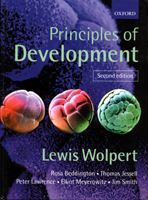





      |
|

Lewis Wolpert, Rosa Beddington, Thomas Jessell, Peter Lawrence, Elliot Meyerowitz, Jim Smith Principles of Development, Second Edition 2002 Oxford University Press ISBN 0-19-924939-3
Developmental biology is at the core of all biology. It deals with the process by which the genes in the fertilized egg control cell behavior in the embryo and so determine its pattern, its form, and much of its behavior. The progress in developmental biology in recent years with the application of advances in cell and molecular biology has been remarkable, and an enormous amount of information is now available. In this second edition, we have included many recent advances, for example in the understanding of somite formation, and this new material is complemented by over 30 additional illustrations. Sections on the development of the heart, the vascular system, and teeth have been added, and we have given more attention, for example, to stem cells, signal transduction, and evolution. Principles of Development is designed for undergraduates and the emphasis is on principles and key concepts. Central to our approach is that development can be best understood by understanding how genes control cell behavior. We have assumed that the students have some very basic familiarity with cell biology and genetics, but all key concepts, such as the control of gene activity, are explained in the text. Conscious of the pressures on students, we have tried to make the principles as clear as possible and to provide numerous summaries, in both words and pictures. The illustrations in this book are a special feature and have been carefully designed and chosen to illuminate both experiments and mechanisms. We have resisted the temptation to cover every aspect of development and have, instead, focused on those systems that best illuminate common principles. Indeed, a theme that runs throughout the book is that universal principles govern the process of development. At all stages, what we included has been guided by what we believe undergraduates should know about development. We have thus concentrated our attention on vertebrates and Drosophila, but not to the exclusion of other systems, such as the nematode and the sea urchin, where they best illustrate a concept. An important feature of our book is the inclusion of the development of plants, which is usually neglected in textbooks. There have been striking advances in plant developmental biology in recent times, and some unique and important features have emerged. As knowing the basic features of the embryology of the main organisms used to study development is essential for an understanding of molecular mechanisms, we have introduced embryology at an early stage. Whereas our emphasis has been on the laying down of the body plans and organ systems, such as limbs and the nervous system, we have also included later aspects of development, including growth and regeneration. The book concludes with a consideration of evolution and development. In providing references, our prime concern has been to guide the students to helpful papers rather than to give credit to all the scientists who have made major contributions: to those whom we have neglected, we apologize. For this new edition we welcome Jim Smith as a co-author and say goodbye to Jeremy Brockes, with thanks for all his help. Each chapter has also been reviewed by a number of experts (see page xix), to whom we give thanks. As with the first edition, I did all the writing-and I mean writingin consultation with my co-authors; it was typed by Maureen Maloney and my revisions were deciphered, edited, and incorporated by our editor Eleanor Lawrence, whose expertise and influence pervades the book. Most of the new illustrations were brilliantly created or adapted by Matthew McClements, who created the illustrations for the first edition. We are indebted to Jonathan Crowe, John Grandidge, and the illustrators at Oxford University Press, our new publishers, for their help and patience throughout the preparation of this new edition. My thanks to Vitek Tracz and Peter Newmark of the Current Science Group, without whom the first edition of this book would never have been started, let alone completed. Finally, and sadly, we are acutely conscious of the loss of Rosa Beddington, who died last year, after a long illness. She was helpful to the end and we miss her terribly.
L. W.
|
 Developmental Biology Published by Elsevier Science under Auspices of Society for Developmental Biology |
|||
|
Page Modified:
|
News | About SDB | Membership | Meetings | Jobs | Education Interactive Fly | Publications | Virtual Library |
© Society for Developmental Biology |